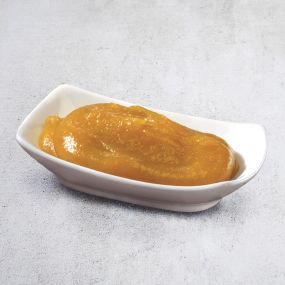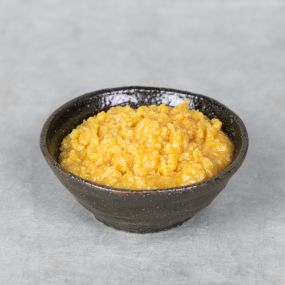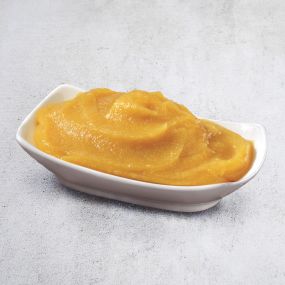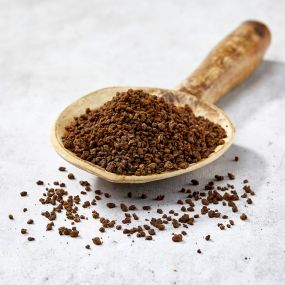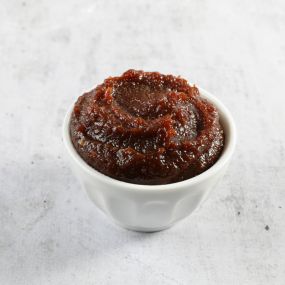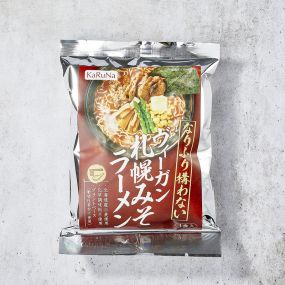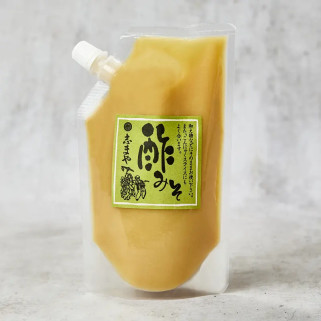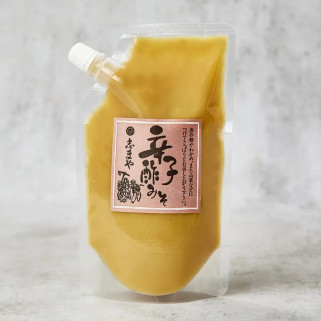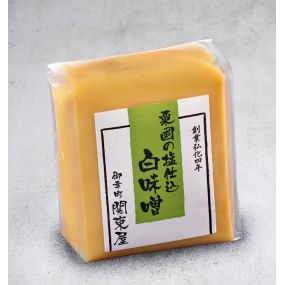This dough is used in Japan in a multitude of dishes, both in simple preparations and in elaborate gastronomic creations. Thanks to Nishikidôir, you have access to an extensive list of carefully selected miso with the best Japanese craftsmen.
Whether you're looking for a light miso for your soups or a finer or more bite dough forsauces rich, pastry preparations or ice creams or chocolate candies ..

METO MANUFACTURER
| MISO Factory Steps |
Miso of rice (Kome-miso) / Miso d'barley (Mugi-miso) |
Miso Pure soy (Mame-Méo) |
| Day 1 |
Washing |
Washing |
| Day 2 |
Steam cooking -> Inoculation of grains with molds of Kôji |
Steam or water cooking -> Preparation of themiso-Dama (Soy transformation into balls) -> inoculation of mold
kôji |
| Day 2-3 |
koji |
koji |
| Day 3 |
Salt mix |
Washing + salt |
| Day 4 and + |
Fermentation with maturation: from 11 months to 3 years |
Fermentation with maturation: from 11 months to 3 years |
The main types of miso and their specificities
Themiso japanese exists in several forms, each with specific features depending on the basic ingredients, the type of Koji used and the fermentation time. You will find below the types of miso and their use:
Miso White (Shiro Miso)
Themiseo, or Shiro Miso, is a softer and less salty dough, most often recommended for those who discover this ingredient.
The shorter fermentation, in general between one and three months, gives it a subtle, slightly sweet flavor and a clear color. This dough is an excellent choice for dishes that require a taste of miso without taking over on other flavors.
At Nishikidôir, we proposemiso rice and soy, Ideal for use in light soups, vinaigrettes or vegetable purees. This delicious dough is also perfectly sealed with creamy dishes to soften and harmonize tastes.
Red Miso (AKA Méo)
Thered miso, or aka miso, is distinguished by its longer fermentation, which can extend over a year or more. This gives it a more pronounced flavor and a dark color.
Used for robust dishes such as stews, thick soups or grilled meat marinades, this miso is perfect for those looking for a more affirmed taste. Nishikidôri offers an organic rice red miso, ideal for raising sauces and accompany meat or fish dishes.
Miso of barley (MUGI MISO)
Variety that uses barley in addition to soy, thebarley has a rounded and little sweet taste. This makes it an excellent choice for simmer dishes or rich vegetable soups.
Traditionally, it is less salty than pure soybean misso and offers a slightly granular texture. We offer barley miso from the best Japanese farms, guaranteeing a superior product for culinary preparations.
100% fermented soybean miso
For those looking for a purer and more rustic miso, the100% soybean miso is an excellent choice. Composed only of soy, this dough provides more dense texture and more intense taste, most often used in dishes where the miso is the central element.
This miso, available at Nishikidôri, is ideal for marinades but also for thicker soups.
Culinary uses of the miso: more than just a soup
Although themiso soupEither probably the most emblematic dish based on Miso, this versatile dough can be used in many ways in cooking. We make suggestions for successful dishes to integrate the MISO into the preparation of its daily revenues.
Traditional miso soup
Themiso soupRemains a must of Japanese cuisine. It's a simple recipe that allows you to take full advantage ofbenefits of the miso. To prepare a miso soup, just dissolve a tablespoon of miso in hot water or brothdashi, then add ingredients like tofu algae and some shiitake mushrooms cooked.
This soup is light, comforting, and can be prepared with miso for a softer flavor, or with red miso for a more full-bodied taste.
Meat and fish marinades
In Japan, the miso is perfect for preparing tasty marinades for meats or fish. Mixed with honey soy sauce, grated ginger and a little garlic, the red or barley miso gives a depth to your dishes.
The fermentation of the miso also helps to tender the proteins, which allows for more juicy meats and tender fish after cooking.
Seasonings and vinaigrettes
This soy paste can also be used to preparevINAIGRETTES AND SAUCES for salads or grilled vegetables. A simple méo vinaigrette can be made by mixing white miso with oil from sesame, rice vinegar and a little mustard.
This type of seasoning adds a subtle flavor to your salads and vegetable dishes, while bringing a dose of essential nutrients.
Sauces for pasta and noodles
For an original touch in a pasta dish, we canIntegrate Miso to Sauces. A miseled miso with cream or coconut milk, fresh ginger and a little soy sauce can for example serve a unctuous support for noodles soba or udon.
It's a creative way to bring a sweet and delicate flavor to his noodle dish.
Use in desserts
Even if it can surprise, the white miso can also be used in desserts. The miso, with its subtle softness, can be added to caramel recipes, creams or ice creams to create an amazing contrast between salty and sweet.
The unique taste of the white miso blends perfectly with sweet flavors like caramel or chocolate.
The benefits of the miso: a treasure of nutrients
The miso is not only appreciated for its taste, it is also a mine of nutrients. Thanks to its fermentation process, this dough is full ofprobiotics, these beneficial bacteria that contribute to intestinal health. In addition to promoting healthy digestion, MISO has several other health benefits.
Rich in protein and vitamins
Miso is an excellentvegetable protein source, particularly appreciated by people adopting a vegetarian or vegan diet. A simple tablespoon of miso can bring up to 2 grams of protein.
This dough is also rich in Vitamins of Group B, including vitamin B12, a fundamental nutrient for brain functioning and energy production.
Full of essential minerals with the miso
In addition to its proteins and vitamins, the miso is asource of essential mineralsLike zinc, copper and manganese. These minerals play an important role in maintaining bone health, skin and immune system.
They also contribute to better regulation of metabolism and protection of cells against oxidative stress.
Natural source of antioxidants
Thanks to the fermentation, the Miso also contains alarge amount of antioxidants, which help fight free radicals and prevent premature aging of cells.
These antioxidants are particularly present in darker misses such as red or barley miso, which undergo longer fermentation.
Immune system support
AUJ Japan, the MISO is generally recommended for strengthen the immune system. Due to its probiotic content and digestive enzymes, it helps maintain a balanced intestinal flora, which is essential for good immunity.
Regular consumption of miso, especially in the form of soup or sauce, can therefore help prevent certain infections, including those related to digestive paths.
Miso: Nishikidoir's handicraftsmanship
At Nishikidoir, we are committed to proposing thebest Miso available on the market, always focusing on quality and authenticity. We work closely with Japanese producers who use traditional and traditional traditional manufacturing methods. Each miso present in our range is the result of a generation-transmitted know-how to generation, thus guaranteeing superior quality. This ensures the success of our products.
Theauthenticity of the products that we select in our list is one of our priorities. We ensure that every step of the production process respects ancestral fermentation techniques, Koji cultivation with misery. We also make suggestions for the list of organic misos for those looking for products free from any chemical. Revenue preparation will be facilitated.
Miso brands proposed by Nishikidôri: an exceptional selection
At Nishikidôir, we put a point of honor to offer you a miso from the best producers in Japan, who perpetuateancestral fermentation methods. Each of the selected brands embodies artisanal know-how and a respectful approach to Japanese traditions.
We offer a list of products with varied flavors, adapted to all tastes and culinary preparations. With our miso, it's the guaranteed success for its cooking recipe.
Kantoya, the art of long fermentation
The brandKantoyaSpecializes in the production of fermented miso over long periods. This slow and thorough process makes it possible to develop rich and complex flavors, typical of the traditional Japanese miso.
The sweet and slightly sweet Kantoya misery mise is perfect for light soups or vinaigrettes. The red miso, fermented longer, brings an ideal depth for simmered dishes and marinades.
Yebisuya, the excellence of organic misso
Yebisuya is a reference for those looking for high quality organic products. Their commitment to reasoned production is reflected in the use of organic certified ingredients, such as soy and rice, and in natural fermentation techniques.
Yebisuya's organic miso is subtle and delicate, while their organic red miso is more intense, perfect for more robust and umami-rich dishes.
Hayakawa Shoyu Miso, authentic regional flavors
Located in the Prefecture of MiyazakiHayakawa Shoyu MisoPerpetuates low temperature fermentation methods, offering miseos rich in aromas and nutrients. Their red miso is intense and complex, ideal for thick soups and simmered dishes.
Their barley miso stands out for its side by a softer and slightly sweet flavor, perfect for light preparations and salad support.
Horiaya Honten, the authenticity of the soil of Niigata
Producer of emblematic miso of the Fukushima regionHoraiya Honten is famous for the quality of its grains and its rice. The Miso of Horaya Honten is mild and creamy, ideal for light sauces and delicate dishes.
Their red miso offers deeper aromas, perfect for accompanying stews, grilled meats or roasted vegetables. With Horaiya Honten, you have the assurance of unparalleled artisanal quality.
Maruya Hatcho Méo, the intensity of the Hatcho Méo
The Hatcho Miso ofMaruya Hatcho Méo is an exceptional product, it has been manufactured for more than 700 years in the Aichi region. This MISO, 100% soy, is fermented for a period of up to three years, thus offering an intensity and wealth without equal.
TheHatcho miso is perfect for dishes requiring a pronounced flavor, such as NABE (Japanese simmers), the Ramen or the thick coulis. This black and dense misse brings a unique depth to all your preparations.
We can choose at the best price the Méo from our list of quality products. Our suggestions for the best brands for Miso will convince.
Nishikidôri: a pledge of authenticity and quality
At Nishikidôir, we carefully select our partners in Japan to offer a list of authentic products, manufactured in respect of the Japanese tradition.
Brands such as Kantoya, Yebisuya, Hayakawa Shoyu Miso, Horaiya Honten and Maruya Hatcho Miso are all guarantees of exceptional quality, where every miso is produced with unique know-how. Thanks to this variety of factory, we will find at Nishikidôir the miso adapted to all his needs, whether light dishes, complex marinades or comforting Japanese soups.
This list of products makes it possible to explore the richness and diversity of Japanese miso, taking advantage of high-end products that respect the artisanal traditions. Whatever the product chosen, we are assured to discover authentic and quality flavors, directly imported from Japan.
Order the Miso at Nishikidôri: a simple and rewarding experience
Buy Miso at Nishikidôri, It's choosing a unique and rewarding Japanese experience. Our site allows you to easily select its favorite products and add them to its wish lists for a later purchase. We propose detailed descriptions of each miso, as well as suggestions for use to guide our customers in their culinary choices.
Whether you are novice in the use of the experienced miso or amateur, all the information needed to select the product that matches your needs. We can also view the opinions of our customers to help to do thebest choice of misoAmong our list of products.
Themiso this is a product that has success in cooking thanks to its wealth of flavors and nutrients. With the selection of exceptional quality misses available at Nishikidôir, you are assured to discover an authentic and delicious product for the preparation of authentic recipes, directly from the Japanese tradition.
Whether you choose a mild miso or a powerful red paste, each product will bring a single touch to its dishes, while contributing to its well-being.

















































